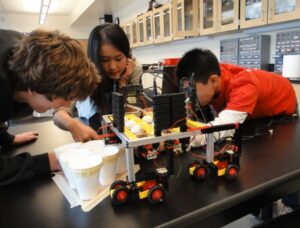
The State Board of Education is grappling with how to teach middle school science aligned to the Next Generation Science Standards. Credit: EdSource file photo
In a surprise move that disappointed California’s top educator but relieved some teachers, the State Board of Education on Wednesday backed away from a proposal that would have radically changed the way middle school students learn science.
The State Board had been expecting to vote on a recommendation to teach integrated science in middle school as part of a conversion to the new Next Generation Science Standards. The change would move away from the traditional discipline-based science education of teaching single subjects each year – biology in one year, for instance, followed by physics or chemistry in subsequent years – to an approach that includes some of each discipline in every grade. Advocates say the “integrated” approach creates a more holistic understanding of science concepts that allows students to better understand connections between, say, the parts of cells and the chemical reactions that allow them to reproduce.
When the proposal came up for a vote, however, the staff of the California Department of Education introduced an alternative plan that would let school districts either teach integrated science or continue to separate the disciplines. The proposal was developed in response to teacher feedback in opposition to the integrated framework.
“I would have preferred the integrated approach,” said State Superintendent of Public Instruction Tom Torlakson after the State Board voted unanimously to support the alternative. Over time, however, Torlakson said he believes the board’s vote will clear a pathway to eventually move schools to a fully integrated approach.
Torlakson, a former high school biology, marine biology and health teacher, said he always integrated other fields of science into his classes.
“It didn’t really make sense in isolation,” said Torlakson, who found that his students grasped biology better when they understood concepts of chemistry as well.
The integrated approach was also recommended by a 27-member Science Expert Panel convened by the state Department of Education to recommend the best way to implement the Next Generation Science Standards in middle school.
The State Board approved those standards in September, but held off on a decision about the model for middle school in order to hear back from teachers and the expert panel.
Phil Lafontaine, the Department of Education’s point person in the national process of developing the science standards, said he realized about two weeks ago that there was so much pushback from some teachers and administrators about the integrated approach that there should be an alternative option available.
Although none of the opponents spoke at the meeting, Lafontaine – also a former high school science teacher who used an integrated approach in his classes – said an online survey created by the department found some teachers were very concerned about the lack of curriculum materials and the amount of professional development required to make the new method work. Others worried that an integrated system wouldn’t be best for their students.
Much like the new Local Control Funding Formula, which allows each district to decide where to focus its budget, Lafontaine said the alternative middle school science proposal lets districts assess their students’ needs and the capacity of schools in their “local context.”
Trish Williams, one of the two state board members involved in the middle school science standards, said she, too, sees the benefits of an integrated curriculum, but also understands that it’s a lot for teachers to deal with while they’re already implementing new Common Core State Standards and the overall Next Generation Science Standards.
It will be better for students to have teachers who are comfortable with the material they’re teaching, Williams said.
“They’ll still be delivering on Next Generation Science Standards,” she noted, but, “It’s better to come with great enthusiasm on the part of the teachers even if it’s not as strong a model.”
The new plan calls for reconvening the science expert panel to develop a strong model for discipline-focused science education aligned to the new science standards. Lafontaine said he wants to move on this as fast as possible to bring it back to the state board in the spring in order to give districts time to develop their science programs for the following school year.
He also suggested to the board members that the Department of Education seek out grant funding to establish pilot programs around the state to study the best way to implement each model.
There isn’t a plethora of research out there about the integrated approach to teaching middle school science, said board President Michael Kirst.
“I don’t think we have the feedback from teachers in the field about the potential problems. It’s conceptual at this point,” he said. “We should take another look at this over time.”
To get more reports like this one, click here to sign up for EdSource’s no-cost daily email on latest developments in education.